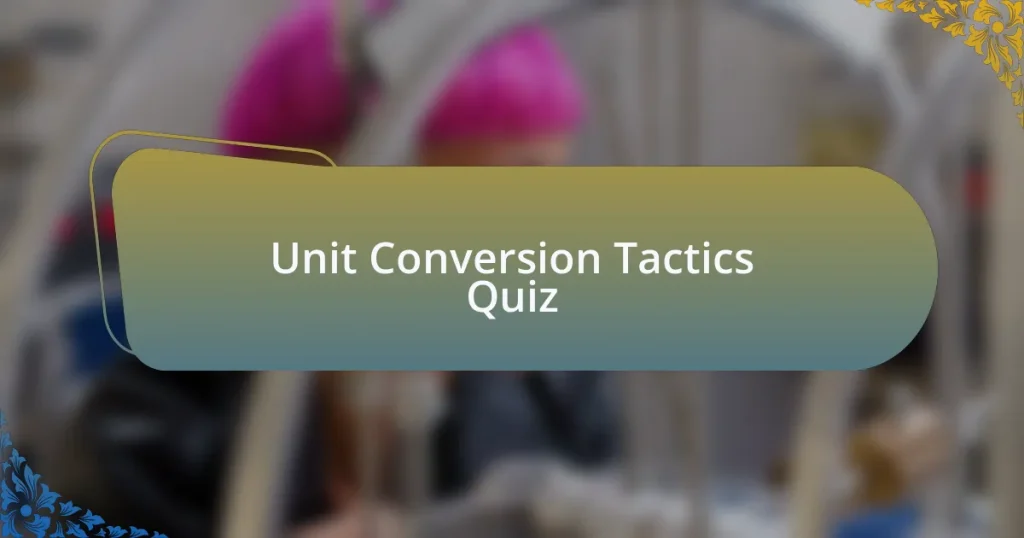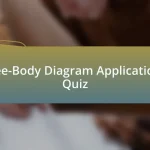Start of Unit Conversion Tactics Quiz
1. Convert 150 cm to meters.
- 15 m
- 0.15 m
- 1.5 m
- 1500 m
2. Convert 75000 mm to meters.
- 7500 m
- 7,500 m
- 75 m
- 750 m
3. Convert 4.5 km to meters.
- 45 m
- 450 m
- 4500 m
- 4.5 m
4. Convert 2.5 liters to milliliters.
- 5000 mL
- 2500 mL
- 1000 mL
- 250 mL
5. Convert 6.4 x 10^3 μL to milliliters.
- 64 mL
- 6.4 mL
- 640 mL
- 6400 mL
6. Convert 1.2 m to milliliters (Note: This conversion is incorrect as milliliters are a unit of volume, not length).
- 0.12 mL
- 1200 mL
- 120 mL
- This conversion is incorrect.
7. Which is greater, 60 kg or 6000 g?
- 6000 kg
- 60 kg
- 6 kg
- 600 g
8. Which is greater, 50 miles or 80 km?
- 80 km
- 70 km
- 50 miles
- 45 miles
9. How many cubic inches are there in a room measuring 4m x 6m x 3m?
- 72,013 in³
- 472,392 in³
- 18,336 in³
- 103,680 in³
10. What is the volume of a 16 oz can of beverage in milliliters?
- 500 mL
- 650 mL
- 473 mL
- 355 mL
11. What is the mass of a 150-lb person in grams?
- 1500 grams
- 6800 grams
- 6800 kg
- 68038 grams
12. What is the height in meters of a 6’0″ person?
- 1.83 m
- 1.75 m
- 1.90 m
- 1.95 m
13. Four gallons of milk costs $12.00. How much does one liter of milk cost?
- $3.17
- $5.00
- $2.50
- $0.30
14. A person runs a 10.0 km race in 50 minutes. How far was the race in miles?
- 6.2 miles
- 8.0 miles
- 5.5 miles
- 4.0 miles
15. If the speed limit was 60 miles per hour, was the driver speeding?
- The speed limit is irrelevant here.
- No, the driver was not speeding.
- Yes, the driver was speeding.
- Speeding depends on traffic conditions.
16. Convert 25.0 g of copper heated from 15.0°C to 30.0°C, what is the specific heat of copper?
- 1.0 J/g·°C
- 0.1 J/g·°C
- 2.0 J/g·°C
- 0.385 J/g·°C
17. What is the base unit for mass in the metric system?
- ounce
- pound
- gram
- kilogram
18. Express 0.000120 in scientific notation.
- 1.2 x 10^-3
- 0.12 x 10^-2
- 1.20 x 10^-4
- 120 x 10^-6
19. In the metric system, what does the prefix micro- mean?
- 10^-9
- 10^-6
- 10^-3
- 10^-12
20. Which of the following is an exact number?
- 2.5 lb
- 100 m
- 3.14
- 4.000 kg
21. When numbers are multiplied, what is the limiting term?
- largest, decimal places
- smallest, significant digits
- final, whole numbers
- average, mean values
22. The conversion factor to change grams to ounces is 1 g = 0.0353 oz.
- 0.0353 oz
- 2.205 oz
- 1 oz
- 0.5 oz
23. Convert 4.0 miles to kilometers.
- 6.4 km
- 3.2 km
- 9.7 km
- 5.0 km
24. What is the mass of a 15.0 mL solution if its density is 0.8 g/mL?
- 10.5 g
- 8.0 g
- 12.0 g
- 15.5 g
25. 100.0°C is equivalent to what in Fahrenheit?
- 150°F
- 212°F
- 100°F
- 0°F
26. Convert 30.0 g of aluminum heated from 20.0°C to 50.0°C, what is the specific heat of aluminum?
- 0.500 J/g·°C
- 0.897 J/g·°C
- 0.900 J/g·°C
- 1.000 J/g·°C
27. What is the volume of a cube with a side length of 10 cm?
- 200 cm³
- 1000 cm³
- 500 cm³
- 3000 cm³
28. Convert 2000 μL to milliliters.
- 20000 mL
- 200 mL
- 2 mL
- 20 mL
29. Convert 250 mL to liters.
- 2.5 L
- 0.025 L
- 0.25 L
- 25 L
30. Convert 3000 L to milliliters.
- 30,000,000 mL
- 3,000,000 mL
- 300 mL
- 30,000 mL
Quiz Successfully Completed!
Congratulations on completing the quiz on ‘Unit Conversion Tactics’! This exercise not only tested your skills but also reinforced essential concepts crucial for physics. You likely gained insights into various units of measurement, learned how to seamlessly switch between them, and understood the significance of precision in calculations.
Unit conversion is a fundamental skill in physics. Mastering it allows you to tackle complex problems with confidence. You now have a better grasp of how different units relate to one another. This understanding is vital when you work with formulas that encompass multiple units. It makes your problem-solving process more efficient and accurate.
We invite you to explore the next section on this page, where you will find detailed information on ‘Unit Conversion Tactics.’ This resource will expand your knowledge further and provide you with practical strategies to enhance your test preparation. Dive in to deepen your understanding and boost your confidence in handling physics problems!
Unit Conversion Tactics
Understanding Unit Conversion in Physics
Unit conversion in physics involves changing a quantity expressed in one set of units to another set of units. This process is essential because different equations and principles in physics may require specific units for accurate calculations. For example, converting meters to kilometers is crucial when measuring distances in different contexts. When performing conversions, one must use conversion factors, which are ratios expressing how many of one unit are equivalent to another. Using these factors ensures that calculations remain consistent and accurate across various physical scenarios.
Common Conversion Factors Used in Physics
In physics, several common conversion factors facilitate the process of converting between units. For length, 1 kilometer equals 1000 meters, allowing easy conversion in distance measurements. For time, 1 hour is equal to 3600 seconds. For mass, 1 kilogram is equivalent to 1000 grams. Familiarity with these conversion factors is crucial as they form the basis of unit conversions, enabling students to tackle problems effectively. Knowing these relationships helps in quickly switching between units without making errors during more complex calculations in physics.
Techniques for Mastering Unit Conversion
Mastering unit conversion requires consistent practice and understanding of dimensional analysis. Students should employ the practice of writing down all units in a problem and systematically applying conversion factors. This technique involves multiplying by fractions where the numerator is the desired unit and the denominator is the original unit, ensuring units cancel correctly. Additionally, practicing with diverse problems enhances speed and accuracy. Incorporating practice problems in various scientific contexts solidifies understanding and application, ensuring readiness for physics tests.
Real-World Applications of Unit Conversion in Physics
Unit conversion plays a vital role in real-world physics applications, such as engineering and environmental science. For instance, when calculating force, it is often necessary to convert units of mass from kilograms to grams to match the required input of certain formulas. Similarly, in fields like meteorology, changing temperature from Celsius to Kelvin is essential for scientific calculations. Understanding these real-life applications illustrates the importance of unit conversion, enabling students to relate theoretical knowledge to practical situations.
Common Mistakes in Unit Conversion and How to Avoid Them
Common mistakes in unit conversion include forgetting to apply conversion factors correctly, leading to inaccurate results. Another frequent error is neglecting to check that units cancel appropriately, sometimes resulting in incorrect final units. Students may also struggle with dimensional analysis, misapplying conversion factors. To avoid these pitfalls, it is critical to double-check each step in the conversion process. Creating a checklist of units involved, conversion factors, and ensuring units are consistent throughout the calculations can significantly reduce errors and improve accuracy in physics tests.
What are Unit Conversion Tactics?
Unit conversion tactics refer to methods and strategies used to convert measurements from one unit to another. This is essential in physics, where different systems of measurement can lead to confusion. For example, converting meters to centimeters or joules to calories is a common practice in physics problems. Effective unit conversion ensures that calculations are accurate and consistent, which is crucial for problem-solving in physics.
How do you convert units in physics?
To convert units in physics, you use conversion factors, which are ratios that express how many of one unit are equivalent to another. For instance, to convert kilometers to meters, multiply by the conversion factor of 1,000 (since 1 km = 1,000 m). This systematic approach allows for precise calculations and maintains dimensional consistency in equations.
Where are unit conversion tactics applied in physics?
Unit conversion tactics are applied in various areas of physics, including mechanics, thermodynamics, and electromagnetism. For example, converting mass from grams to kilograms is critical when using formulas involving force, such as Newton’s second law (F=ma). Accurate unit conversions enable the correct application of these laws and their associated calculations.
When should you use unit conversion in physics problems?
Unit conversion should be employed in physics problems whenever measurements are given in different units than those required for calculations. For instance, if a problem provides speed in meters per second but requires distance in kilometers, a conversion is necessary. This ensures that all quantities are expressed in compatible units before performing calculations.
Who benefits from understanding unit conversion tactics in physics?
Students, educators, and professionals in science and engineering benefit from understanding unit conversion tactics in physics. For students preparing for physics tests, mastering these conversions enhances problem-solving skills and boosts confidence. Educators use these tactics to teach fundamental concepts, while professionals apply them in research and practical applications to ensure accuracy in their work.















